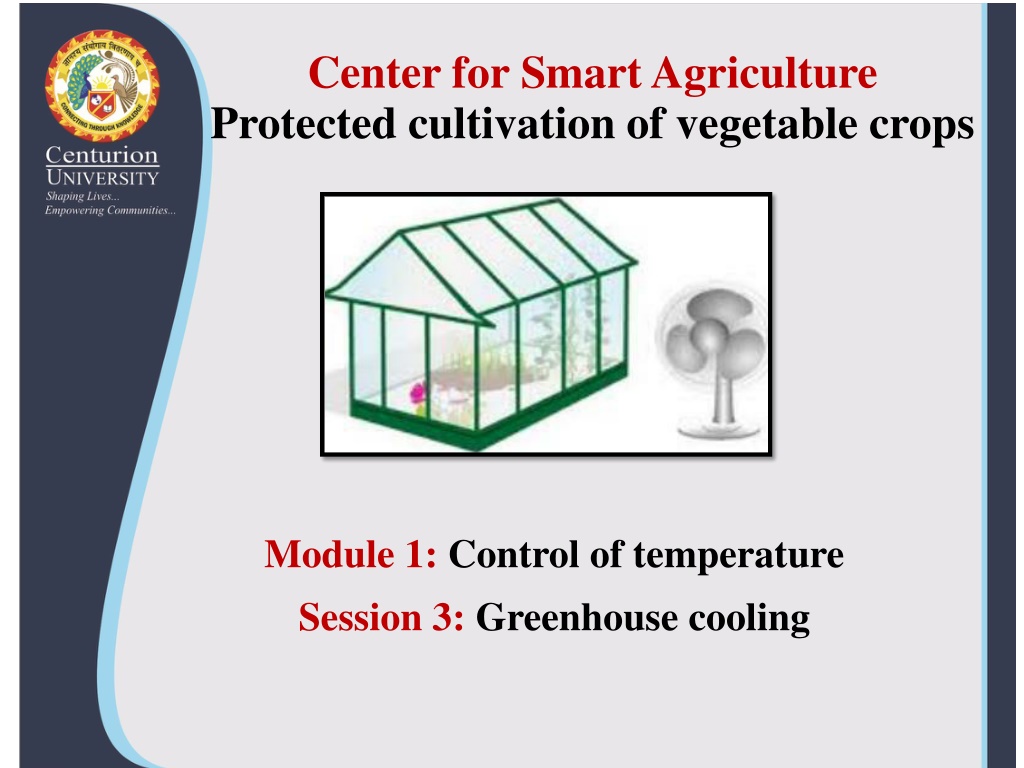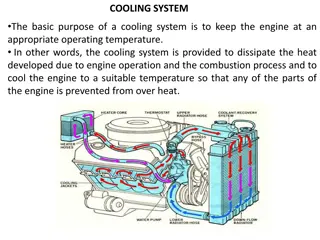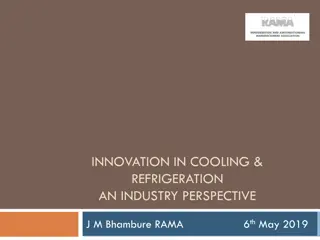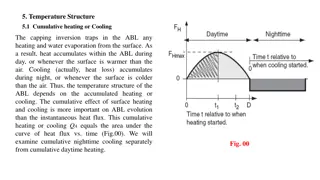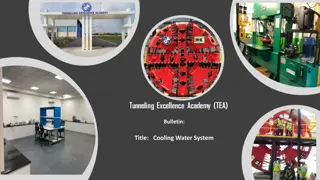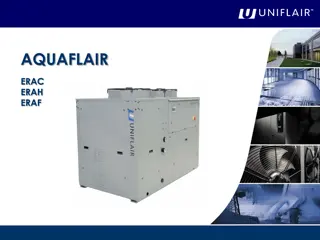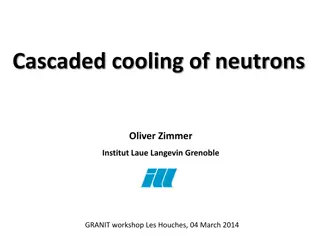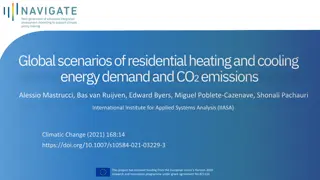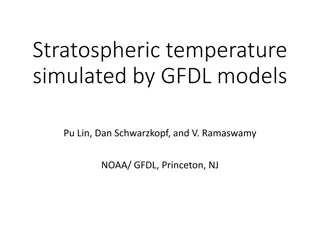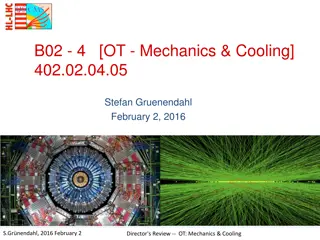Efficient Greenhouse Cooling Systems for Smart Agriculture
Active summer cooling systems like fan-and-pad and fog systems are crucial for maintaining optimal temperatures in greenhouses. These systems work by utilizing evaporation to remove heat from the air. Fan-and-pad cooling systems have been in use since 1954, where water is passed through pads to cool the surrounding air. Proper ventilation and fan placement are essential for efficient cooling, with considerations for the distance between pads and fans. Regular maintenance is necessary to prevent clogging and ensure the cooling systems operate effectively.
Download Presentation

Please find below an Image/Link to download the presentation.
The content on the website is provided AS IS for your information and personal use only. It may not be sold, licensed, or shared on other websites without obtaining consent from the author. Download presentation by click this link. If you encounter any issues during the download, it is possible that the publisher has removed the file from their server.
E N D
Presentation Transcript
Center for Smart Agriculture Protected cultivation of vegetable crops Module 1: Control of temperature Session 3: Greenhouse cooling
Active summer cooling systems The process of evaporation requires heat that is removed from the air surrounding the evaporating water. The two active summer cooling systems in use presently are fan-and pad and fog systems Fan-and Pad cooling system: Available since 1954 H20 is passed through a pad that is usually placed vertically in the wall
. Distance of 30 to 61m Traditionally Pad - excelsior (wood shreds) Today - a cross-fluted cellulose material some what similar in appearance to corrugated card board Khus-khus grass mats can also be used as cooling pads. Exhaust fans - opposite wall.
Warm outside air is drawn in through the pad. The supplied water in the pad - process of evaporation - absorbs heat (cooling effect) As the air moves across the house to the fans, it picks up heat from solar radiation, plants, and soil, and the temperature of air increases gradually. Fans: Regardless of the type of pad material used, the fans should have the capacity to provide a minimum of one air change per minute in the greenhouse. Equip the fans with automatic shutters to eliminate back drafts when a fan is not operating.
The greater the range of the crop's temperature tolerance, the greater the distance between pad and fans can be. It is not practical to separate the pad and exhaust fans by more than 200 feet. A distance of 150 feet or less is preferred. Problems with cooling pads: They lose efficiency due to clogging from impurities in the water, algae growth and decay. If the pad material is clogged or decomposed its ability to function as designed is impaired.
Ventilation and cooling fans equipped with anti-back draft shutters
Fog cooling system Introduced in green houses in 1980, same cooling principle as the fan and pad cooling system but uses quite different arrangement A high pressure generates fog (mean size of <10 microns) using suitable nozzles. These droplets are sufficiently small to stay suspended in air while they are evaporating pumping apparatus
Fog is dispersed throughout the green house, cooling the air everywhere. As this system does not wet the foliage, there is less scope for disease and pest attack. The fan-and pad system can lower the temperature of incoming air by about 80% of the difference between the dry and wet bulb temperatures while the fog cooling system can lower the temperature by nearly 100 % difference.
Active winter cooling systems Excess heat can be a problem during the winter. In the winter, the ambient temperature will be below the desired temperature inside the green house. Owing to the green house effect the entrapment of solar heat can rise the temperature to an injurious level if the green house is not ventilated. The actual process in winter cooling is tempering the excessively cold ambient air before it reaches the plant zone. Otherwise, hot and cold spots in the green house will lead to uneven crop timing and quality.
This mixing of low temperature ambient air with the warm inside air cools the green house in the winter. The actual process in winter cooling is tempering the excessively cold ambient air before it reaches the plant zone. Otherwise, hot and cold spots in the green house will lead to uneven crop timing and quality. This mixing of low temperature ambient air with the warm inside air cools the green house in the winter.
Convection tube cooling The general components of convection tube are the louvered air inlet, a polyethylene convection tube with air distribution holes, a pressurizing fan to direct air in to the tube under pressure, and an exhaust fan to create vacuum. When the air temperature inside the green house exceeds the set point, the exhaust fan starts functioning thus creating vacuum inside the green house.
The louver of the inlet in the gable is then opened through which cold air enters due to the vacuum. The pressurizing fan at the end of the clear polyethylene convection tube, operates to pick up the cool air entering the louver. A proper gap is available for the air entry, as the end of the convection tube is separated from the louvered inlet by 0.3 to 0.6m and the other end of the tube is sealed. Round holes of 5 to 8 cm in diameter are provided in pairs at opposite sides of the tube spaced at 0.5 to 1m along the length of the tube
Cold air under pressure in the convection tube shoots out of holes on either side of the tube in turbulent jets. cool mixed air, being heavier gently flows own to the floor level, effects the complete cooling of the plant area.
Horizontal air flow cooling HAF cooling system uses small horizontal fans for moving the air mass and is considered to be an alternative to convection tube for the air distribution. In this method the green house may be visualized as a large box containing air and the fans located strategically moves the air in a circular pattern. Move air at 0.6 to 0.9 m3/min/m2 of the green house floor area
Fractional HP of fans is 31 to 62 W (1/30 to 1/15hp) with a blade diameter of 41cm are sufficient for operation. Fans - 0.6 to 0.9m above pht & 15m Intervals They are arranged such that the air flow is directed by one row of the fans along the length of the GH down one side to the opposite end and then back along the other side by another row of fans
Temperatures at plant height are more uniform same exhaust fans, inlet louvers and controls as the convection tube system. only difference is the use of HAF fans in the place of convection tubes for the air distribution Cold air entering through the louvers located at the higher level in the gables of the green house is drawn by the air circulation created by the net work of HAF fans and to complete the cycle, proper quantity of air is let out through the exhaust fans. The combined action of louvered inlet, HAF fans and the exhaust fans distribute the cold air throughout the greenhouse.
Cold air entering through the louvers located at the higher level in the gables of the green house is drawn by the air circulation created by the net work of HAF fans and to complete the cycle, proper quantity of air is let out through the exhaust fans. The combined action of louvered inlet, HAF fans and the exhaust fans distribute the cold air throughout the greenhouse.
